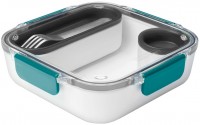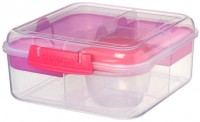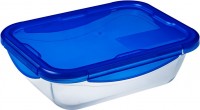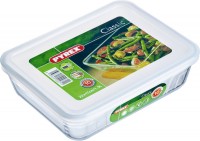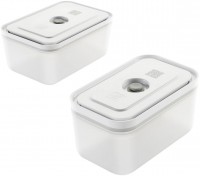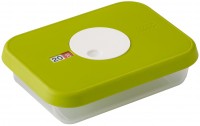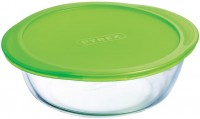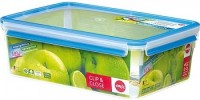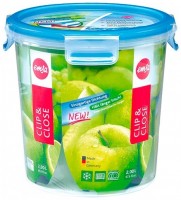Food Containers Mepal
All Food Containers Advanced filters → |
You might be interested in
Food Containers: specifications, types
Type
— Container. In this case, containers are understood as fairly simple vessels, designed mainly for the storage and transportation of food and supplied one in a set. However, such models may have various additional functions (see below), sometimes quite extensive. However, anyway, the main compartment in such a container does not have partitions, so the containers are mainly designed to carry homogeneous products (or several types of food that are not afraid of contact with each other and partial mixing). However, there are also models with several compartments; however, unlike lunch boxes(see below), in containers these compartments are usually stacked on top of each other.
— Set. As the name implies, the set includes several containers at once (at least 2). Usually, these are classic containers (see above) of different volumes, and sometimes even proportions (for example, some are low, others are elongated in height). The owner of the set has at hand several trays of various capacities at once, which allows him to choose the best option depending on the situation — including packaging a large amount of food, for which one container is not enough. At the same time, many sets can be "packed" according to the principle of a nesting doll — a smaller container inside a larger one — which makes them quite convenient to store. The specific number of items in the kit may vary, see below for more details....
— Launch Box. The name of such containers literally translates as "lunch box", and it describes well their main purpose — carrying lunches taken "to go" from home to school, work, etc. In addition, a lunch box usually also plays the role of dinner utensils — the design allows you to comfortably eat directly from such a container. The main difference between a lunch box and a regular food container (see above) is the presence of several compartments located next to each other and separated by partitions. Thanks to this, you can load different types of products inside without fear that they will mix; and to access all the content at once, just open the lid. In addition, in some models, the compartments are made in the form of removable containers, which gives even more opportunities — for example, you can not heat the entire lunch box in the microwave, but only part of its contents. But lunchboxes are not suitable for long-term storage of food: the compartments are not hermetically sealed from each other, and products can be “saturated” with smells from neighboring compartments, which worsens the taste and can lead to premature spoilage.
— Heated Lunch Box. Lunch boxes with a heating function provide an opportunity to provide a person with hot home-cooked food in the office or during long car trips. The heating element in their design is usually placed at the bottom. The internal space of the lunch boxes is divided by one or more partitions, and there can also be a separate container with a lid for salads and desserts, which can be removed before heating. Depending on the model and power level, the reheating time for lunch is between five minutes and half an hour. There are models powered by a standard household outlet and a car cigarette lighter socket.
— Set. As the name implies, the set includes several containers at once (at least 2). Usually, these are classic containers (see above) of different volumes, and sometimes even proportions (for example, some are low, others are elongated in height). The owner of the set has at hand several trays of various capacities at once, which allows him to choose the best option depending on the situation — including packaging a large amount of food, for which one container is not enough. At the same time, many sets can be "packed" according to the principle of a nesting doll — a smaller container inside a larger one — which makes them quite convenient to store. The specific number of items in the kit may vary, see below for more details....
— Launch Box. The name of such containers literally translates as "lunch box", and it describes well their main purpose — carrying lunches taken "to go" from home to school, work, etc. In addition, a lunch box usually also plays the role of dinner utensils — the design allows you to comfortably eat directly from such a container. The main difference between a lunch box and a regular food container (see above) is the presence of several compartments located next to each other and separated by partitions. Thanks to this, you can load different types of products inside without fear that they will mix; and to access all the content at once, just open the lid. In addition, in some models, the compartments are made in the form of removable containers, which gives even more opportunities — for example, you can not heat the entire lunch box in the microwave, but only part of its contents. But lunchboxes are not suitable for long-term storage of food: the compartments are not hermetically sealed from each other, and products can be “saturated” with smells from neighboring compartments, which worsens the taste and can lead to premature spoilage.
— Heated Lunch Box. Lunch boxes with a heating function provide an opportunity to provide a person with hot home-cooked food in the office or during long car trips. The heating element in their design is usually placed at the bottom. The internal space of the lunch boxes is divided by one or more partitions, and there can also be a separate container with a lid for salads and desserts, which can be removed before heating. Depending on the model and power level, the reheating time for lunch is between five minutes and half an hour. There are models powered by a standard household outlet and a car cigarette lighter socket.
Containers per set
The total number of individual containers supplied in the set (see "Type").
The more containers, the greater their diversity and the wider the choice of the user. At the same time, the variety can be not only in terms of volume, but also in proportions, and even in shape: for example, in sets of 5 items or more, there can be “high” and “low” containers, square containers can be combined with round ones, etc. .P.
It is worth remembering that “a lot” does not always mean “good”: an extensive set may require a lot of space, and it will cost accordingly. Therefore, when choosing, it is worth considering the real needs.
The more containers, the greater their diversity and the wider the choice of the user. At the same time, the variety can be not only in terms of volume, but also in proportions, and even in shape: for example, in sets of 5 items or more, there can be “high” and “low” containers, square containers can be combined with round ones, etc. .P.
It is worth remembering that “a lot” does not always mean “good”: an extensive set may require a lot of space, and it will cost accordingly. Therefore, when choosing, it is worth considering the real needs.
Min. capacity
The volume of the smallest container included in the set (see "Type"). In fact, there are quite a few situations when you need to pack a small amount of food, and a large container is not required. On the other hand, if the set is planned to be used regularly for numerous products, then perhaps the smallest tray should be quite large. See "Maximum Volume" for details on specific volumes.
Max. capacity
The largest volume of the container supplied with the kit. For sets (see "Type") in this case, the capacity of the largest container is indicated, for all other types — the actual nominal volume. Useful volume may be somewhat less, because. not all containers and not in all cases can be stuffed “under the very lid”. However, this difference is small, and this figure characterizes the capacity of the product well.
Estimating the amount of food that can fit inside, we can proceed from the fact that 1 liter of volume approximately corresponds to 1 – 1.2 kg of soup or a tightly packed product (for example, mashed potatoes) or 700 – 800 g of food, divided into pieces and not packed very tightly (for example, fried potatoes or salad). A large container takes up more space, and too little food can hang around inside, which usually does not contribute to safety. Therefore, too large a volume is just as undesirable as too small.
Estimating the amount of food that can fit inside, we can proceed from the fact that 1 liter of volume approximately corresponds to 1 – 1.2 kg of soup or a tightly packed product (for example, mashed potatoes) or 700 – 800 g of food, divided into pieces and not packed very tightly (for example, fried potatoes or salad). A large container takes up more space, and too little food can hang around inside, which usually does not contribute to safety. Therefore, too large a volume is just as undesirable as too small.
Compartments in 1 container
The number of separate compartments provided in the design of the container. The presence of several compartments allows you to put heterogeneous products inside, preventing contact between them: for example, you can load a “main course”, a salad and a couple of fruits for dessert into a three-compartment lunch box. Actually, it is for lunch boxes that the presence of several compartments is mandatory; see "Type" for details. But in traditional containers, such a design is rare, and the compartments are located not “side by side”, but one above the other. This is convenient for long-term storage of food, because. each compartment is securely closed and odours from the contents do not penetrate into the "foreign" compartment.
Dimensions (HxWxD)
Container dimensions in height, width and depth; for round containers (see "Shape") after the height, only one size is indicated — the diameter. Information about the dimensions allows you to evaluate the proportions of the container (in models of the same volume, they may be different) and determine what specific space it will need.
Material
The main material used in the construction of the container, more precisely, the material from which the container itself is made. Cover material may vary; actually, in models made of solid materials ( glass, stainless steel, ceramics, porcelain), the covers are still made of plastic or silicone, because. to perform them from the "native" material is impractical for a number of reasons.
— Plastic. The main advantage of plastic is its low cost. In addition, this material has a low weight, good strength and can sag noticeably under load; the latter allows you to slightly "squeeze" plastic containers to fit in tight spaces (if the contents allow, of course). Also note that plastic is most often made transparent, which allows you to see the contents without opening the tray; this is especially important for vacuum packed containers (see "Functions/Characteristics"). On the other hand, there are a fairly large number of different types of plastic on the market, and not all of them are suitable, for example, for long-term storage, loading hot foods or using in the microwave — these properties should be paid special attention when choosing a plastic container, because . if the conditions of use are violated, plastic can release harmful substances. Theoretically, the release of such substances can also occur upon contact with acidic foods (berries, vinegar...-based salads, etc.) — they are also not recommended to be stored in plastic containers. Also note that plastic is rather reluctant to wash off fat — sometimes you need to expend a lot of effort to completely wash the container, especially in the corners.
— Glass. The advantages of glass are, firstly, transparency, which allows you to see the contents, and secondly, general practicality. So, this material is completely chemically inert, which allows you to store absolutely any products in glass containers; it normally tolerates both low and fairly high temperatures, is compatible with microwave ovens and dishwashers. On the other hand, glass is not suitable for "camping" containers and is designed mainly for storing food at home. This is due to a number of properties. Firstly, this material is quite fragile and can break on impact. Secondly, the glass itself is quite heavy, and to give it the necessary strength, it is also made thick, which further affects the weight. Thirdly, it is very difficult to provide a tight-fitting lid on such a container, and most models open when turned over (although there are quite reliable products that are suitable even for liquids). Also note that glass is sensitive to sudden changes in temperature, which is why a heated container cannot be placed immediately under cold water — it can crack.
— Silicone. The synthetic polymer material, which looks like plastic, is also quite elastic and becomes transparent. At the same time, silicone has a number of advantages. So, it is compatible with almost any product and does not emit harmful substances, and also tolerates contact with hot contents and microwave heating well. Silicone containers most often have tight-fitting lids that are safe even when turned over. The main disadvantage of this material is its rather high cost.
— Stainless steel. This category includes two types of material — pure "stainless steel", which does not have special coatings, as well as enameled. Anyway, the most noticeable advantage of steel is its high strength — such a container will not break even from a fairly strong impact, and the elasticity of the material also prevents the appearance of dents. In addition, many containers made of this material are able to withstand fairly strong heat — up to use in the oven for baking. But steel containers are in principle incompatible with microwave ovens. In addition, they have other disadvantages. So, steel is opaque, and you can only see the contents without opening the container through the lid. And the lid itself most often does not close very tightly, and it is undesirable to turn such a container over when filled (although there are exceptions). It is also believed that non-enamelled steel containers are not well suited for long-term storage of wet food — despite the "stainless" properties, some oxidation is inevitable, which may cause the taste of the contents to deteriorate.
— Ceramics. Classic ceramic materials, similar to those used in dinner plates and other utensils. In terms of practical properties and application, they are similar to glass (in particular, they are designed mainly for permanent storage in one place), but on the one hand, usually, they are opaque, on the other hand, they are more resistant to temperature extremes. In addition, ceramics are usually decorated with drawings or ornaments, and in general, this option is designed for those who need not only practical, but also beautiful looking containers.
— Porcelain. A specific type of ceramic (see above), which has all the characteristic practical properties, but has a very pleasant appearance and is used mainly for design reasons. In general, porcelain containers look elegant, but they are also expensive.
— Plastic. The main advantage of plastic is its low cost. In addition, this material has a low weight, good strength and can sag noticeably under load; the latter allows you to slightly "squeeze" plastic containers to fit in tight spaces (if the contents allow, of course). Also note that plastic is most often made transparent, which allows you to see the contents without opening the tray; this is especially important for vacuum packed containers (see "Functions/Characteristics"). On the other hand, there are a fairly large number of different types of plastic on the market, and not all of them are suitable, for example, for long-term storage, loading hot foods or using in the microwave — these properties should be paid special attention when choosing a plastic container, because . if the conditions of use are violated, plastic can release harmful substances. Theoretically, the release of such substances can also occur upon contact with acidic foods (berries, vinegar...-based salads, etc.) — they are also not recommended to be stored in plastic containers. Also note that plastic is rather reluctant to wash off fat — sometimes you need to expend a lot of effort to completely wash the container, especially in the corners.
— Glass. The advantages of glass are, firstly, transparency, which allows you to see the contents, and secondly, general practicality. So, this material is completely chemically inert, which allows you to store absolutely any products in glass containers; it normally tolerates both low and fairly high temperatures, is compatible with microwave ovens and dishwashers. On the other hand, glass is not suitable for "camping" containers and is designed mainly for storing food at home. This is due to a number of properties. Firstly, this material is quite fragile and can break on impact. Secondly, the glass itself is quite heavy, and to give it the necessary strength, it is also made thick, which further affects the weight. Thirdly, it is very difficult to provide a tight-fitting lid on such a container, and most models open when turned over (although there are quite reliable products that are suitable even for liquids). Also note that glass is sensitive to sudden changes in temperature, which is why a heated container cannot be placed immediately under cold water — it can crack.
— Silicone. The synthetic polymer material, which looks like plastic, is also quite elastic and becomes transparent. At the same time, silicone has a number of advantages. So, it is compatible with almost any product and does not emit harmful substances, and also tolerates contact with hot contents and microwave heating well. Silicone containers most often have tight-fitting lids that are safe even when turned over. The main disadvantage of this material is its rather high cost.
— Stainless steel. This category includes two types of material — pure "stainless steel", which does not have special coatings, as well as enameled. Anyway, the most noticeable advantage of steel is its high strength — such a container will not break even from a fairly strong impact, and the elasticity of the material also prevents the appearance of dents. In addition, many containers made of this material are able to withstand fairly strong heat — up to use in the oven for baking. But steel containers are in principle incompatible with microwave ovens. In addition, they have other disadvantages. So, steel is opaque, and you can only see the contents without opening the container through the lid. And the lid itself most often does not close very tightly, and it is undesirable to turn such a container over when filled (although there are exceptions). It is also believed that non-enamelled steel containers are not well suited for long-term storage of wet food — despite the "stainless" properties, some oxidation is inevitable, which may cause the taste of the contents to deteriorate.
— Ceramics. Classic ceramic materials, similar to those used in dinner plates and other utensils. In terms of practical properties and application, they are similar to glass (in particular, they are designed mainly for permanent storage in one place), but on the one hand, usually, they are opaque, on the other hand, they are more resistant to temperature extremes. In addition, ceramics are usually decorated with drawings or ornaments, and in general, this option is designed for those who need not only practical, but also beautiful looking containers.
— Porcelain. A specific type of ceramic (see above), which has all the characteristic practical properties, but has a very pleasant appearance and is used mainly for design reasons. In general, porcelain containers look elegant, but they are also expensive.
Shape
General shape of the container(s). Please note that extensive sets (see “Type”) may include containers of different shapes; for such cases, the option that most containers correspond to is usually indicated; the remaining options are given in the notes.
The most popular shapes are classic geometric shapes - circle, oval, square, rectangle. At the same time, containers that differ slightly in the length of the sides can also be classified as squares - if this difference is not noticeable to the eye. Non-standard containers are also produced, often they have an original design - for example, a semicircle with an orange slice coloring.
The shape determines the appearance, overall ease of placement of the container and ease of cleaning. So, for example, round containers have a minimum of corners, and some are generally made in the shape of a hemisphere - which makes them easier to clean compared to square and rectangular ones. On the other hand, square and rectangular containers are most useful when storing in tight spaces, such as a busy refrigerator - they can be stacked as tightly as possible, side by side, whereas round containers will inevitably have gaps between them.
The most popular shapes are classic geometric shapes - circle, oval, square, rectangle. At the same time, containers that differ slightly in the length of the sides can also be classified as squares - if this difference is not noticeable to the eye. Non-standard containers are also produced, often they have an original design - for example, a semicircle with an orange slice coloring.
The shape determines the appearance, overall ease of placement of the container and ease of cleaning. So, for example, round containers have a minimum of corners, and some are generally made in the shape of a hemisphere - which makes them easier to clean compared to square and rectangular ones. On the other hand, square and rectangular containers are most useful when storing in tight spaces, such as a busy refrigerator - they can be stacked as tightly as possible, side by side, whereas round containers will inevitably have gaps between them.
Features
The type of products for which the container is intended.
— For food. The most common type of containers, intended mainly for solid food (in the broad sense of the word — second courses, sandwiches, etc.). Some models can be equipped with tight-fitting lids and are also suitable for liquids, but this point needs to be clarified separately. And in general, the variety of functions and materials can be quite extensive, so the compatibility of the container with specific types of food is also worth checking before buying.
— For liquids. Specialized models designed primarily for liquids. A distinctive feature of such containers are tight lids with latches that can be closed very tightly and held in place even when turned over. In addition, containers for liquids most often have a round shape and a rather large height (in other words, they look elongated upwards) — this allows you to conveniently pour the liquid by tilting the container. There are other options in shape, but they are still designed for the convenience of working with liquids. This option is useful primarily for carrying ready-made first courses — soups, noodles in broth — and other liquid products, such as vitamin cocktails.
— For the salad. Containers intended for salad may well be used with other products, however, regular use is still the most convenient and practical. "Salad" containers are usually round and often made of glass or ceramics: these materials tolerate contact w...ith vinegar, sour vegetables and other similar products, and the appearance of such a container often allows it to be used even as a salad bowl. However, relatively inexpensive models are also produced, made of plastic (see "Material").
— For food. The most common type of containers, intended mainly for solid food (in the broad sense of the word — second courses, sandwiches, etc.). Some models can be equipped with tight-fitting lids and are also suitable for liquids, but this point needs to be clarified separately. And in general, the variety of functions and materials can be quite extensive, so the compatibility of the container with specific types of food is also worth checking before buying.
— For liquids. Specialized models designed primarily for liquids. A distinctive feature of such containers are tight lids with latches that can be closed very tightly and held in place even when turned over. In addition, containers for liquids most often have a round shape and a rather large height (in other words, they look elongated upwards) — this allows you to conveniently pour the liquid by tilting the container. There are other options in shape, but they are still designed for the convenience of working with liquids. This option is useful primarily for carrying ready-made first courses — soups, noodles in broth — and other liquid products, such as vitamin cocktails.
— For the salad. Containers intended for salad may well be used with other products, however, regular use is still the most convenient and practical. "Salad" containers are usually round and often made of glass or ceramics: these materials tolerate contact w...ith vinegar, sour vegetables and other similar products, and the appearance of such a container often allows it to be used even as a salad bowl. However, relatively inexpensive models are also produced, made of plastic (see "Material").
Min. temperature
The minimum temperature that a container can safely tolerate. Almost all modern food containers normally tolerate positive temperatures. So you should pay attention to this parameter only if the container is planned to be used for deep freezing, or used in harsh winter conditions. However, the minimum temperature in domestic freezers is rarely below -24 °C, while for food containers it is -40 °C as a standard. On the other hand, it is worth noting that many models have no mention of a minimum temperature at all; it is necessary to use such products in the cold, taking into account the materials from which they are made (see above), and if possible, refrain from doing so altogether.
Max. temperature
The maximum temperature that the container can safely endure. Note that overheating the container can lead not only to its damage, but, in some cases, also to the release of harmful substances. Therefore, in no case should the claimed temperature be exceeded — even if the container remains intact, this does not mean that everything is fine.
The most delicate modern food containers have a maximum limit of 35 – 40 °C — this allows them to be used only for unheated food. Values of 70 °C are already found even among models compatible with microwave ovens, although for maximum guarantee it is desirable that the allowable temperature be at least 100 °C. And the most heat-resistant products (usually heat-resistant glass) can withstand temperatures up to 300 – 400 °C and can even be used for baking in the oven (although this heat resistance usually does not apply to lids, and they must be removed).
The most delicate modern food containers have a maximum limit of 35 – 40 °C — this allows them to be used only for unheated food. Values of 70 °C are already found even among models compatible with microwave ovens, although for maximum guarantee it is desirable that the allowable temperature be at least 100 °C. And the most heat-resistant products (usually heat-resistant glass) can withstand temperatures up to 300 – 400 °C and can even be used for baking in the oven (although this heat resistance usually does not apply to lids, and they must be removed).
Max. heating temperature
The heating temperature of the contents, which can be provided by containers and lunch boxes with a food warming function. Usually this parameter is in the range of 60 – 70 °C. In fact, the maximum temperature for heating food depends on the material of manufacture of the box (metal, ceramic and glass containers withstand temperature changes more resistant than plastic products), as well as the power of the heating element.
Power consumption
The time for heating food for different models with a heating function varies from a few minutes to half an hour. It directly depends on the parameter of the power consumption of the heater. The higher this indicator, the faster the lunch box will warm up lunch when connected to a 230 V household outlet or 12 V car cigarette lighter socket.
Functions
— Use in the microwave oven. Possibility of using the container in a microwave oven. Far from all materials are suitable for such ovens: for example, metal cannot be put there in principle, some plastics are not heat-resistant enough, and some containers do not pass microwaves well and heat up more than the contents themselves. Therefore, for use in microwaves, it is worth choosing models for which such a possibility is directly stated.
— Vacuum. Containers allowing the possibility of vacuum packaging. A mandatory feature of such models is a hermetically sealed lid equipped with an air evacuation valve. Pumping is carried out using a pump, which may or may not be included in the delivery, there are also models where the role of the pump is played by a mechanism built right into the lid; these features for each model should be specified separately. Anyway, vacuum storage promotes preservation and kills most of the bacteria, which, in particular, can lead to spoilage of the contents. This function is especially convenient for long-term storage, it allows you to "extend the life" of even perishable products. On the other hand, not all products tolerate vacuum well (for example, soft vegetables can burst from internal pressure).
— Foldable. Containers are able to significantly reduce their size when not in use. This is mainly achieved by reducing the heigh...t. The principle of operation is telescopic — each next section is slightly smaller and slides into the previous one.
— Latched lid. A lid fitted with latches to secure it to the container. This feature significantly increases the reliability of the lid — it will not fly off, even if the container is turned over. In addition, latches contribute to the tightness of closing, although they are far from always able to provide full tightness.
— Setting the date on the lid. The presence of a mechanical "calendar" on the lid that allows you to set a specific date — for example, the day of packaging, or the expiration date of the contents. This feature allows you to easily control the residence time of the products in the container.
— Hinged lid. The presence in the design of the container of a lid fixed directly on the container — as a result of which such a lid is not removed when opened, but leans back (hence the name). The convenience of such covers lies in the fact that, unlike traditional removable ones, they are practically not lost. In addition, when opening, you do not need to look for a place where to put the lid — this is especially convenient in the case of lunch boxes (see "Type"), from which people often eat right at the workplace or in other poorly adapted environments. Although most models with hinged lids are still classic containers. The disadvantages of such designs are some bulkiness and the inability to open the lid in cramped conditions.
— Carrying handle. The presence of a special carrying handle in the design of the container. This handle is usually placed on top, like in a bucket, but there are also models with a side handle that resemble cups. Anyway, this function makes it easier to hold the container in your hands, which is important, first of all, with a large capacity, with an inconvenient shape for carrying (for example, in the form of a round “barrel” of great height) or if there is hot contents inside, which noticeably heated up the outer walls.
— Vacuum. Containers allowing the possibility of vacuum packaging. A mandatory feature of such models is a hermetically sealed lid equipped with an air evacuation valve. Pumping is carried out using a pump, which may or may not be included in the delivery, there are also models where the role of the pump is played by a mechanism built right into the lid; these features for each model should be specified separately. Anyway, vacuum storage promotes preservation and kills most of the bacteria, which, in particular, can lead to spoilage of the contents. This function is especially convenient for long-term storage, it allows you to "extend the life" of even perishable products. On the other hand, not all products tolerate vacuum well (for example, soft vegetables can burst from internal pressure).
— Foldable. Containers are able to significantly reduce their size when not in use. This is mainly achieved by reducing the heigh...t. The principle of operation is telescopic — each next section is slightly smaller and slides into the previous one.
— Latched lid. A lid fitted with latches to secure it to the container. This feature significantly increases the reliability of the lid — it will not fly off, even if the container is turned over. In addition, latches contribute to the tightness of closing, although they are far from always able to provide full tightness.
— Setting the date on the lid. The presence of a mechanical "calendar" on the lid that allows you to set a specific date — for example, the day of packaging, or the expiration date of the contents. This feature allows you to easily control the residence time of the products in the container.
— Hinged lid. The presence in the design of the container of a lid fixed directly on the container — as a result of which such a lid is not removed when opened, but leans back (hence the name). The convenience of such covers lies in the fact that, unlike traditional removable ones, they are practically not lost. In addition, when opening, you do not need to look for a place where to put the lid — this is especially convenient in the case of lunch boxes (see "Type"), from which people often eat right at the workplace or in other poorly adapted environments. Although most models with hinged lids are still classic containers. The disadvantages of such designs are some bulkiness and the inability to open the lid in cramped conditions.
— Carrying handle. The presence of a special carrying handle in the design of the container. This handle is usually placed on top, like in a bucket, but there are also models with a side handle that resemble cups. Anyway, this function makes it easier to hold the container in your hands, which is important, first of all, with a large capacity, with an inconvenient shape for carrying (for example, in the form of a round “barrel” of great height) or if there is hot contents inside, which noticeably heated up the outer walls.
In box
— Thermal bag. A carrying bag with an increased degree of thermal insulation and ensuring long-term preservation of the temperature of the products loaded into the container. Usually supplied with kits (see "Type"). The advantage of a complete thermal bag over a separately purchased one is that it fits perfectly under “their” containers. On the other hand, the need for such equipment rarely arises, it is not cheap, and the selection of a third-party thermal bag is not difficult. Therefore, this function is not particularly popular.
— Bag. A regular bag used for storing and transporting containers. It does not provide such advanced thermal insulation as a thermal bag (see above), but it is much cheaper; the rest is completely similar.
— Cutlery. Cutlery — usually a classic set of a spoon, fork and knife, although other options may occur (for example, the original "spoon fork" with teeth cut right into the front of the cup). A feature of this configuration is that such containers usually have their own compartment for cutlery — for example, in the lid. It is more convenient to carry such a set with you than to pack a spoon-fork-knife separately. On the other hand, complete cutlery can be somewhat less convenient than traditional cutlery — in particular, they are often made of plastic.
— Cold accumulator. A device that increases the time of pr...eservation of cold inside the container and can even turn it into a makeshift micro-refrigerator. The cold accumulator is a sealed reservoir filled with a liquid with a high heat capacity. Such a battery is “charged” in the refrigerator (ideally, in the freezer), after which it is placed inside the container and intensively absorbs excess heat. Of course, there is no question of particularly long-term storage, but when storing perishable products outside the refrigerator (especially in the heat), this function is extremely useful.
— Bag. A regular bag used for storing and transporting containers. It does not provide such advanced thermal insulation as a thermal bag (see above), but it is much cheaper; the rest is completely similar.
— Cutlery. Cutlery — usually a classic set of a spoon, fork and knife, although other options may occur (for example, the original "spoon fork" with teeth cut right into the front of the cup). A feature of this configuration is that such containers usually have their own compartment for cutlery — for example, in the lid. It is more convenient to carry such a set with you than to pack a spoon-fork-knife separately. On the other hand, complete cutlery can be somewhat less convenient than traditional cutlery — in particular, they are often made of plastic.
— Cold accumulator. A device that increases the time of pr...eservation of cold inside the container and can even turn it into a makeshift micro-refrigerator. The cold accumulator is a sealed reservoir filled with a liquid with a high heat capacity. Such a battery is “charged” in the refrigerator (ideally, in the freezer), after which it is placed inside the container and intensively absorbs excess heat. Of course, there is no question of particularly long-term storage, but when storing perishable products outside the refrigerator (especially in the heat), this function is extremely useful.
Country of origin
Country of origin of the brand under which food containers are marketed. Usually, it is indicated by the "homeland" of the manufacturing company or by the location of its headquarters.
There are many stereotypes associated with the “nationality” of brands and products, but most of them have no basis nowadays. First, the actual place of production is often different from the brand's country of origin. Secondly, the quality of the goods depends not so much on geography, but on the policy of a particular company and how carefully this very quality is controlled in it. Therefore, you should pay attention to the country of origin of the brand only if you fundamentally want or (do not want) to support a manufacturer from a certain state. Quality is best judged by the reputation of a particular brand and the general price category.
There are many stereotypes associated with the “nationality” of brands and products, but most of them have no basis nowadays. First, the actual place of production is often different from the brand's country of origin. Secondly, the quality of the goods depends not so much on geography, but on the policy of a particular company and how carefully this very quality is controlled in it. Therefore, you should pay attention to the country of origin of the brand only if you fundamentally want or (do not want) to support a manufacturer from a certain state. Quality is best judged by the reputation of a particular brand and the general price category.

